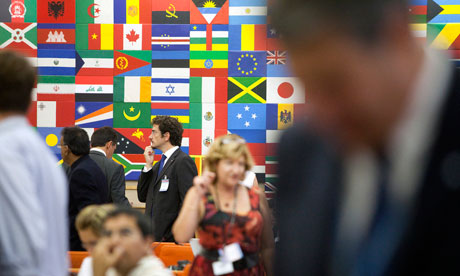Food and Agriculture Organisation representatives and international officials take stock of disaster and assess what action to take to avoid repetition of Horn of Africa crisis
- guardian.co.uk,
- Article history

An international emergency meeting in Rome examines measures to address the crisis in the Horn of Africa and to mobilise international support for affected countries. Photograph: Giulio Napolitano/FAO
International agricultural experts on Thursday stressed the need for long-term measures to avoid a repetition of the crisis in the Horn of Africa that has left 12 million hungry.
As aid agencies poured supplies into Mogadishu, Somalia, the country most severely affected through a combination of drought and conflict, officials at the Food and Agriculture Organisation held a second emergency meeting in less than a month to take stock of the humanitarian disaster.
While acknowledging the need for immediate emergency aid, they emphasised the need for actions and policies to prevent famine from recurring. "We must think not only about saving lives today, but build sustainable livelihoods to avoid future calamities," said Jacques Diouf, the FAO president. "What the world is seeing now is the unfortunate result of three decades of underinvestment in agriculture and underdevelopment."
He said while countries in the region had prepared comprehensive investment plans for agriculture, funding was missing. "Unless these plans are carried out, famine will return to shame the international community," said Diouf. "With the financial resources, technology and expertise at our disposal, it is inadmissible for 12 million people to be at risk of starvation today. We have the opportunity to help these people out of crisis by building more livelihoods more resilient to climate shocks."
Kenya's agriculture minister, Romano Kiome, said long-term solutions to drought had not been taken seriously. He stressed the need to make available drought-resistant seeds to farmers, building small irrigation projects as well as infrastructure, so that food can be moved quickly round the region. Kiome also said the world needed to make the link between the problems of food production and climate change.
The FAO meeting was part of a flurry of diplomatic activity focusing on the Horn, where relief agencies are in a race against time as the famine is expected to spread in Somalia in the coming months. The Organisation of the Islamic Conference countries pledged $350m in aid for Somalia at an emergency summit in Istanbul on Wednesday and the African Union is to hold a pledging conference in Addis Ababa, the Ethiopian capital, next week.
Andrew Mitchell, the international development secretary, who visited Mogadishu on Wednesday, warned that up to 400,000 children could die through starvation if urgent action is not taken to help Somalia and its neighbours.
As Mitchell visited Mogadishu, Britain announced an extra £25m ($41m) in emergency aid for Somalia. The new package will go through Unicef, allowing the UN organisation for children to double the number of children it is reaching in its supplementary programme.
Across Somalia, 3.7 million people – nearly half of the Somali population – are now in crisis, two-thirds of whom reside in the south, which is under the control of al-Shabaab, the Islamist militants, who oppose the presence of the UN's World Food Programme in the belief that food aid undermines local food production. Unicef, however, does have a presence in the south as its focus on children is deemed more acceptable than the WFP's.
The crisis has forced tens of thousands of Somalis to flee to neighbouring countries, including Ethiopia, Djibouti and, particularly, Kenya. The number of refugees at Kenya's Dadaab complex has reached 400,000. The UNHCR, the UN body for refugees, today started moving 200 people into the camp known as Ifo 2 – part of the new Ifo extension site. Ifo 2, which has 116 brick houses, had been standing empty for months because of growing local opposition to the influx of refugees.
The refugees are being bussed in from the outskirts of Dagahaley, one of the three camps at Dadaab, where recently arrived refugees are living in very difficult conditions, with poor sanitation and little access to services or security. The plan is to move around 90,000 people into the Ifo extension camps by November. So far around 17,000 refugees have moved into the Ifo extension site.
While welcoming the consensus in Rome, Oxfam pointed out that a huge funding gap remained despite fresh aid pledges this week.
"This week some rich countries and donors that were lagging behind have stepped up and pledged more funds," said Penny Lawrence, international director of Oxfam Great Britain. "Yet, there's a gaping hole of nearly $1bn in funding for the emergency response, not to mention for the longer road to recovery that will require sustained international investment.
"The clock is ticking for east Africa, and the African Union governments that are meeting next week must show their determination to make this Africa's last famine."

No comments:
Post a Comment